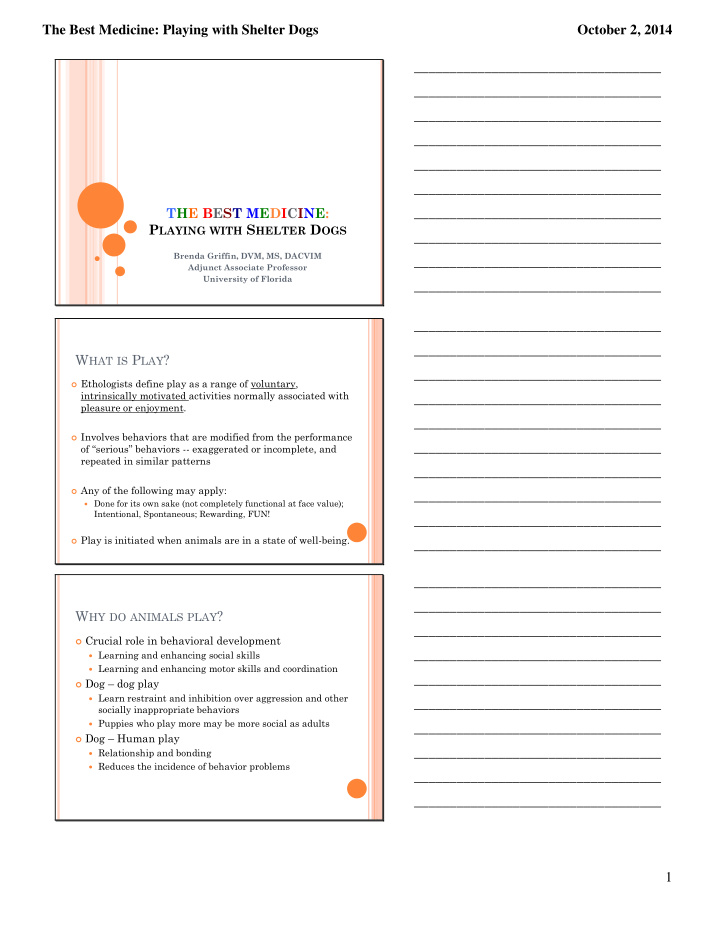



The Best Medicine: Playing with Shelter Dogs October 2, 2014 ___________________________________ ___________________________________ ___________________________________ ___________________________________ ___________________________________ ___________________________________ THE BEST MEDICINE: ___________________________________ P LAYING WITH S HELTER D OGS ___________________________________ Brenda Griffin, DVM, MS, DACVIM ___________________________________ Adjunct Associate Professor University of Florida ___________________________________ ___________________________________ ___________________________________ W HAT IS P LAY ? ___________________________________ Ethologists define play as a range of voluntary, intrinsically motivated activities normally associated with ___________________________________ pleasure or enjoyment. ___________________________________ Involves behaviors that are modified from the performance ___________________________________ of “serious” behaviors -- exaggerated or incomplete, and repeated in similar patterns ___________________________________ Any of the following may apply: ___________________________________ Done for its own sake (not completely functional at face value); Intentional, Spontaneous; Rewarding, FUN! ___________________________________ Play is initiated when animals are in a state of well-being. ___________________________________ ___________________________________ ___________________________________ W HY DO ANIMALS PLAY ? ___________________________________ Crucial role in behavioral development Learning and enhancing social skills ___________________________________ Learning and enhancing motor skills and coordination ___________________________________ Dog – dog play Learn restraint and inhibition over aggression and other ___________________________________ socially inappropriate behaviors Puppies who play more may be more social as adults ___________________________________ Dog – Human play Relationship and bonding ___________________________________ Reduces the incidence of behavior problems ___________________________________ ___________________________________ 1
The Best Medicine: Playing with Shelter Dogs October 2, 2014 ___________________________________ W HAT CONSTITUTES DOG PLAY BEHAVIOR ? ___________________________________ Dog play behavior is comprised of components of ___________________________________ the predatory sequence ___________________________________ Search (nose) Dog are ___________________________________ Stalk predators – Rush ___________________________________ Chase Play behavior is Bite/Grab/Hold ___________________________________ predatory Tug/Shake/Kill behavior! ___________________________________ Rip/Shred/Chew Guard your share ___________________________________ Exaggerated, incomplete, repeated in similar sequences ___________________________________ ___________________________________ ___________________________________ T HE LANGUAGE OF PLAY ___________________________________ “Normal” play is often ROUGH and INTENSE Owners/caregivers often want to curb it “in case the dog ___________________________________ becomes aggressive” Owners/caregivers are not good at ascertaining the ___________________________________ difference between play and aggression ___________________________________ Studying body language and signaling is key ___________________________________ Play involves ‘give and take’ ___________________________________ Pauses or breaks are needed to allow emotions to settle (so that over-arousal does not occur) ___________________________________ Play styles and preferences vary Dogs are individuals ___________________________________ ___________________________________ T HE LANGUAGE OF PLAY ___________________________________ Play bow Open mouthed play face ___________________________________ Low tail wag Lateral movement ___________________________________ Side stance/twist/spin Exaggerated, repetitive movements ___________________________________ Bouncing, lunging, face pawing Approach, retreat ___________________________________ Chasing Chase me posture – jump and tag, jumps backward and looks, nipping ___________________________________ Body slamming Belly up (self-handicapping) ___________________________________ Wrestling/neck biting Zoomies ___________________________________ Barking – excitement bark, higher tone – or the fun police Growling ___________________________________ Arousal – piloerection, dilated eyes, wild eyes, high tail – loose/wiggly 2
The Best Medicine: Playing with Shelter Dogs October 2, 2014 ___________________________________ D O DOGS RESPOND TO SIGNALS TO PLAY ___________________________________ FROM HUMANS ? ___________________________________ ___________________________________ Videotaped 21 owners and their dogs Specific actions used by humans do ___________________________________ communicate a playful context to dogs Lunging and bowing, especially ___________________________________ combined with vocalizing were the most frequent signals to instigate play ___________________________________ ___________________________________ ___________________________________ Rooney, Bradshaw, Robinson. Do dogs respond to play signals given by humans ? Animal Behaviour. 61(4) 715-722, 2001. ___________________________________ ___________________________________ ___________________________________ P LAY AND WELFARE ___________________________________ “Animal welfare is usually considered primarily in terms of the animal’s negative experiences. Four of the ___________________________________ ‘Five Freedoms’ are freedoms from unpleasant experiences (hunger/thirst; discomfort; ___________________________________ pain/injury/disease; fear/distress), and only one ___________________________________ potentially addresses positive aspects of welfare (freedom to perform normal behavior). ” ___________________________________ ___________________________________ Phillips. Animal welfare: A construct of positive and negative affect? The Veterinary Journal. 175; 291 – 292, 2008. ___________________________________ ___________________________________ ___________________________________ ___________________________________ ___________________________________ Welfare is not merely the ___________________________________ absence of negative ___________________________________ experiences, but also the ___________________________________ presence of positive ones. ___________________________________ ___________________________________ ___________________________________ ___________________________________ 3
The Best Medicine: Playing with Shelter Dogs October 2, 2014 ___________________________________ ___________________________________ W ELFARE MONITORING ___________________________________ Normal, species typical behaviors Dogs need to be able to be dogs. ___________________________________ Happy dogs PLAY! ___________________________________ ___________________________________ ___________________________________ ___________________________________ ___________________________________ ___________________________________ ___________________________________ ___________________________________ P LAY AS A BEHAVIORAL MARKER OF WELFARE ___________________________________ Animals in positive affective states may play more frequently ___________________________________ ___________________________________ Positive affect enhances cognitive states, affecting how animal process ___________________________________ and learn ___________________________________ ___________________________________ ___________________________________ Yeates and Main. Vet J . Assessment of positive welfare: a review. 175(3): 293-300. 2007. ___________________________________ ___________________________________ T HE I MPACT OF POSITIVE VERSUS ___________________________________ NEGATIVE E MOTIONAL S TATES ___________________________________ Human psychology research suggests that changes in cognitive function (i.e., how we ___________________________________ process information) is impacted by our emotional state. ___________________________________ For example, people in negative states attend to ___________________________________ threats, retrieve negative memories, and make negative judgment about ambiguous stimuli ___________________________________ more than happier people. Emerging area of animal welfare research: ___________________________________ investigating the possibility that such affect- induced ‘cognitive biases’ also occur in animals. ___________________________________ ___________________________________ 4
Recommend
More recommend